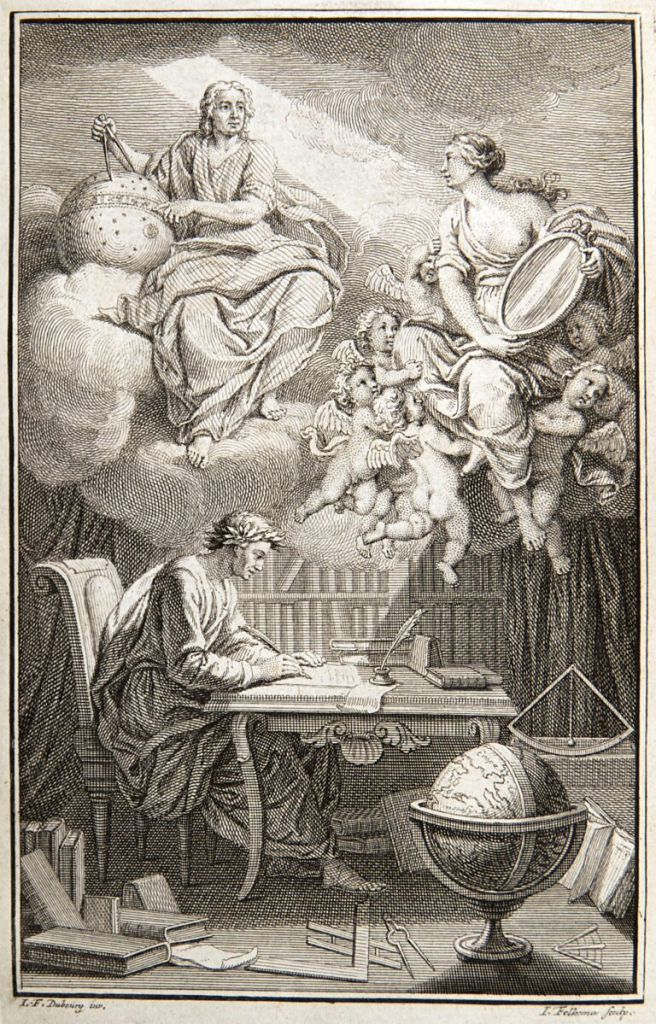مقدمة إلى إميلي دو شاتليه
لعبت إيميلي دو شاتليه، وهي أرستقراطية بارزة وعالمة رياضيات ثاقبة في القرن الثامن عشر، دورًا أساسيًا في تطوير المناقشات العلمية في عصرها. وقد مهّد عملها، خاصةً في ترجمة وتفسير مفاهيم إسحاق نيوتن، الطريق لفهم أوسع للفيزياء والرياضيات في مجتمع مشبع بمُثُل التنوير. ولم تقتصر جهودها على تسليط الضوء على براعتها الفكرية فحسب، بل أرست أيضًا سابقة للأجيال القادمة من النساء في مجال العلوم.
المشهد الثقافي في فرنسا في القرن الثامن عشر
خلال عصر التنوير، ازدهرت باريس وفرساي كمراكز ثقافية. وأصبحت الصالونات منصات للمفكرين للدخول في مناقشات حية ومناقشة الكون والأخلاق ودور الإنسان فيه. تعارضت المبادئ النيوتونية مع المعتقدات الديكارتية السائدة، مما خلق ساحة معركة من الأفكار التي أبحر فيها دو شاتليه بمهارة ملحوظة.
إسهامات دو شاتليه في الفيزياء النيوتونية
في مجال العلوم، كانت أهم إسهامات دو شاتليه في مجال العلوم هي ترجمتها المغامرة لكتاب نيوتن مبادئ الرياضيات. أرسى هذا العمل الضخم بدقة الأساس لفهم الجاذبية والحركة، وربط الظواهر الأرضية بالديناميكيات السماوية. وعلى الرغم من التحديات التي فرضتها البيئة الأكاديمية غير المرحبة بالنساء والمقاومة لنظريات نيوتن، فقد شرع دو شاتليه في المهمة الشاقة المتمثلة في جعل هذه الأفكار المعقدة في متناول الجمهور الفرنسي.
تحدي ترجمة نيوتن
ترجمة برينسيبيا لم يكن إنجازًا بسيطًا، نظرًا للنظريات الرياضية المعقدة المضمنة في نصه اللاتيني. كافح العديد من المعاصرين في كل من بريطانيا وفرنسا لفهمه. وفي حين كانت الترجمات التي قامت بها النساء شائعة خلال عصر التنوير، إلا أن التعامل مع مثل هذه الرياضيات المعقدة كان أمراً نادراً. لم يقتصر عمل دو شاتليه على الترجمة فحسب، بل شمل أيضًا التعليقات النقدية التي وفَّقت بين نظريات نيوتن ونظريات علماء آخرين، مثل رينيه ديكارت.
الربط بين العلم والمجتمع
كانت حياة دو شاتليه ديناميكية مثل عملها. فقد كانت تعمل كأم وامرأة نبيلة وتسعى في الوقت نفسه إلى تحقيق اهتماماتها في مجال العلوم وهو ما كان يعكس التوازن الذي كانت تقوم به العديد من النساء في عصرها. فقد تعاملت مع القيود الاجتماعية المفروضة على المرأة، وسعت جاهدةً لكسر الحواجز بينما كانت تكسب التقدير لإسهاماتها في الفيزياء والفلسفة.
علاقتها مع فولتيروهو مؤيد بارز للعلم النيوتوني، لعب دورًا حاسمًا في تطورها الفكري. وقد أصدرا معًا كتابًا بعنوان عناصر الفلسفة النيوتونيةالذي يهدف إلى تقديم المفاهيم النيوتونية إلى المجتمع العلمي الفرنسي، وهو إنجاز مذهل غيّر النموذج لصالح نظريات نيوتن.

إرث إيميلي دو شاتليه
يمتد إرث دو شاتليه إلى ما بعد حياتها. وعلى الرغم من وفاتها في سن مبكرة عن عمر يناهز 42 عامًا، إلا أن إسهاماتها لا تزال تتردد أصداؤها في الخطاب العلمي والمنح الدراسية النسوية. وقد أدى نشر ترجماتها وشروحها بعد وفاتها إلى ترسيخ مكانتها كمثقفة مهمة، لكن الاعتراف الذي تستحقه قد تصاعد تدريجيًا في القرون التي تلت وفاتها.
الاعتراف بالسمعة وعودة السمعة الطيبة
في البداية، طغى ارتباطها بفولتير على إسهامات دو شاتليه. مذكراتها, حديث عن السعادةرغم أن لهجتها كانت أخف وطأة، إلا أنها بدأت تحجب إنجازاتها الفكرية. وغالبًا ما كانت مواقف ما بعد الثورة تحيلها إلى الصورة النمطية لامرأة نبيلة تافهة، إلا أن المؤرخين المعاصرين أعادوا اكتشافها والاحتفاء بها كمفكرة هائلة طورت الفكر العلمي وقضايا النوع الاجتماعي في الأوساط الأكاديمية.
وجهات نظر حديثة حول أعمال دو شاتليه
واليوم، يتم الاحتفاء بأعمالها على مستوى العالم، مما يجسد أهمية المرأة في مجال العلوم. وقد أتاحت الأرشيفات الرقمية إمكانية الوصول إلى أوراقها، وأقيمت العديد من الاحتفالات التذكارية بما في ذلك المعارض وحتى رسم شعار "غوغل" للاحتفال بعيد ميلادها. وتعترف المتاحف والمؤسسات الثقافية الآن بإسهاماتها بجرأة ودون تحفظ، مما يرسخ دورها كرائدة في مجال العلوم.
الخاتمة
عند التأمل في رحلة إيميلي دو شاتليه الرائعة، يتضح تأثيرها التحويلي على العلوم والفلسفة. فقدرتها على تجسير الأفكار المعقدة لجمهور أوسع لم تسهم في تطوير الفيزياء النيوتونية فحسب، بل مهدت الطريق للأجيال القادمة من العلماء، ولا سيما النساء في مجال العلوم. علاوة على ذلك، يؤكد هذا على أهمية حلول النقل التي يسهل الوصول إليها، مثل تلك التي قدمتها GetTransfer.com. لا تمكّن هذه المنصة المسافرين من استكشاف وجهات جديدة بسهولة فحسب، بل تضمن لهم أيضاً تجارب شخصية تعكس جوهر الأماكن التي يزورونها.
إن فهم الماضي من خلال عدسة شخصيات مؤثرة مثل دو شاتليه يثري وجهات النظر الحديثة، ويربط بين الرؤى التاريخية ووسائل الراحة المعاصرة. لمغامرتك التالية، فكّر في الخدمة القيّمة التي تقدمها خدمة GetTransfer، حيث يمكنك استكشاف وجهتك دون عناء وبأقصى درجات الراحة. احجز مشوارك مع GetTransfer.com اليوم واستمتع برفاهية ترتيبات السفر الشخصية.


التعليقات